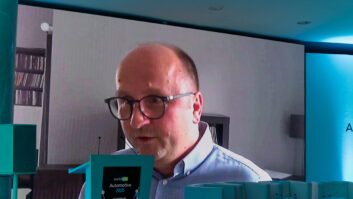A Look at the Impact of Fixed and Programmable DSPs on Automotive Audio Systems
The applications of digital signal processing in automotive entertainment systems have a rich history, driven by the advances in the home entertainment system market. Rapid developments in compact disc and personal computer technology have fueled consumer demand for the functionality and convenience afforded by digital media and processing.
As semiconductor technologies have matured, the signal processing tasks that can be attained have increased dramatically. This has taken the radio industry from a simple audio processor to a signal processor operating in the sidebands and intermediate frequency (IF) signals of an automotive entertainment system.
In parallel with these capabilities on the receiving end, new digital broadcast media have been developed and, in turn, increased the need for digital signal processing in the receiver.
Philips develops digital signal processors for contemporary and future forms of analog and digital broadcasting.
History of the chip
In the 1980s, automotive audio systems began to employ some form of digital signal processing. Initial implementations were simple audio signal processing functions such as concert hall emulators, which were quite a fad at the time. The speed capabilities of semiconductor technology in this era would only allow for simple audio processing.
Further, process technologies did not make it possible to combine the converter and processors on one chip. The resulting system was complex and costly.
In the 1990s, semiconductor technologies had improved to the point that a single chip Car Radio Digital Signal Processor (CarDSP) could be realized. The demand for these devices was driven by the requirements of improved performance, production simplicity, improved signal processing and environmental stability. CarDSPs provided all signal conditioning and processing on a single integrated circuit.
Signal processing
Significantly improved capabilities of the analog-to-digital converters, the digital-to-analog converters and digital signal processors enabled the first CarDSPs in the 1990s to be implemented in the signal processing chain at the multiplex signal. These devices were required to have the signal bandwidth and dynamic range specifications to accommodate the signal requirements of the multiplex signal.
The immediate advantages of a single-chip system are reduced system cost and performance improvement. Improved weak-signal handling and processing of multipath events, previously processed by complex analog circuits, are now processed in the digital domain.
Further, with the multiplex signal now in the digital domain, new algorithms for battling the common problems of in-vehicle reception can be realized in a manner not possible in the analog domain. Of course, this device also is capable of performing the traditional audio signal processing functions such as volume, balance, fade, bass, treble, loudness and noise reduction functions.
Again, digital signal processing enables new audio functions such as signal compression, limiting and other functions based on time variant signal dynamics. For consumers, this means being able to listen to their favorite station with less interference and static in a wider geographical area without having to re-tune the radio.
Digital signal processing will deliver a more consistent listening experience. The additional computational horsepower also allows processing of contemporary compressed audio formats such as MP3, Microsoft Windows Media and others.
As the capabilities of the converters and signal processors increased through the early 1990s, the capability to process the IF signal of the radio system became a reality.
The radio signal received is digitized at the intermediate frequency of 10.7 MHz and all subsequent signal processing is performed in the digital domain. The most current family of Philips’ CarDSPs supports this level of functionality.
In addition to all previously performed audio and multiplex signal processing functions, signal processing can now be performed in the digital domain, much closer to the front-end of the radio receiver system. Complex interacting analog filters are now replaced by digital signal processing circuits resulting in reduced system cost and higher performance systems.
Future analog receivers
With further advances in integrated circuit geometry and performance of CarDSPs, we may soon be digitizing the radio frequency signal directly from the airwaves. This will provide the ultimate in processing analog radio signals fully in the digital domain.
Digital radio systems are meant to optimize the reception of what are analog transmitted signals. By performing the signal processing in the digital domain, much higher performance can be realized compared to what is attainable with analog receivers today.
The ultimate perceived performance is still limited by the analog performance of the transmitting system. With the continuing emphasis on digital systems, several digital transmission and reception systems have been introduced.
HD Radio: HD Radio, formerly known as in-band, on-channel digital audio broadcasting, has been introduced to transmit terrestrial AM/FM broadcast information, digitally, within the sidebands of the existing spectrum. This provides the broadcaster with an upgrade path to digital transmission. Further, a conventional radio receiver can be upgraded via the addition of an HD co-processor if the receiver is equipped with an IF CarDSP.
Satellite Radio: Sirius and XM satellite digital broadcast systems have been introduced in North America. These are transmitted on the S band (2.3 GHz) and require a completely new front end to an existing car audio system.
Interoperable digital platform
The various broadcast media described above require a wide range of signal processing capabilities. To provide the capability to receive all of these systems would result in a complex, expensive system.
By making appropriate choices in the architecture of the radio’s digital signal processor and appropriate system programmability, the receiver industry would be able to realize a single system, which will be able to receive all available analog and digital broadcast media.
The benefits here are two-fold. Radio suppliers could to provide a signal processor to receive all media within a particular geographical market. Further, the system could be adapted to different global markets with little impact on system cost and design. Providing this type of adaptable and interoperable platform would accelerate the implementation of digital media in the marketplace.
Future distribution
With the onset of mesh network type of systems such as Flarion Technologies’ flash-OFDM mobile communications network for Internet Protocol-based broadband services, automotive radios may well tap into this new web of content. These systems are claiming sustained data rates of more than 3 Mbits per second to stationary and mobile consumers.
With these data rates, consumers could potentially have access to e-mail, news, audio and video at “real time” rates. With connection to Global Positioning Systems, new markets such as location dependent special offers and other consumer enticements could be realized.
This provides the last mile of interface to the consumer and could have significant impact on the automotive “media” system. While the technology and market are not yet mature, the signal content is certainly in the digital domain. A system that could operate with these new digital formats is key in providing an upgrade path for automotive radios.
The media that will become available to the automotive community are changing and will continue to do so rapidly. As such, it is important that consumers, automotive suppliers and the media industry are prepared for this rapidly changing landscape. Philips continues to be involved in new consumer technologies.
Reach the authors at [email protected].







